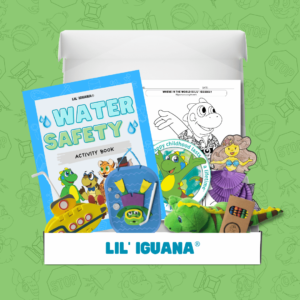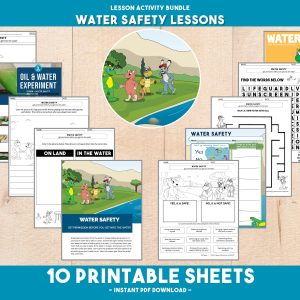How to Teach Water Safety to Young Kids
explaining potential dangers of water, such as pools, lakes, rivers, and oceans
Water play activities can help strengthen a children’s fine motor skills. Kids enhance their coordination and gross motor skills by moving in the water like carrying, lifting, pouring, and splashing. Water is great for a child’s development, but it’s important to be prepared. Teaching your child how to be safe around bodies of water is essential for their well-being. Make sure they understand how to get permission before entering the water.
Ten important steps to teach your child how to be safe around water:
- Start with the basics: Begin teaching your child about water safety from an early age with Lil’ Iguana’s lesson guide. Explain the potential dangers of bodies of water, such as swimming pools, lakes, rivers, and oceans. Get in the water to show some fundamentals.
- Supervision is key: Always emphasize the importance of adult supervision around water. Stress that they should never go near or enter the water without a trusted adult present, even if they know how to swim.
- Teach swimming skills: Get in the water with them or enroll your child in swimming lessons to teach them basic swimming skills. Learning to swim can greatly reduce the risk of accidents in the water.
- Educate about outdoor water environments: Teach your child about different types of water hazards. For example, discuss the dangers of currents in rivers or tides at the beach. Ensure they understand the risks associated with each type of environment.
- Emphasize the buddy system: Encourage your child to always swim with a buddy or be near other people when in or around water. Having a companion increases safety and provides an extra set of eyes to watch out for each other.
- Teach water entry and exit points: Show your child where it’s safe to enter and exit the water. Explain that jumping or diving into unknown or shallow water can be dangerous and cause injury.
- Teach about dangerous water activities: Make your child aware of activities that are risky around water, such as running on wet surfaces, pushing others in the water, or playing with toys. Educate them about the potential consequences of these actions.
- Pool safety: If you have a swimming pool at home, ensure it has appropriate safety measures in place, such as a fence with a self-latching gate and a pool cover. Teach your child about the specific rules and guidelines for using the pool safely.
- First aid and emergency response: Explain basic first aid skills to your child, such as reaching or throwing aids to someone in distress instead of jumping in. Make sure they know how to call for assistance and provide them with important contact numbers.
- Be a role model: Children often learn by observing their parents or guardians. Show your child the importance of practicing water safety by following the guidelines yourself. Always wear appropriate Coast Guard approved safety gear, such as life jackets.
Printable Activity
Tag @LiliguanaSafety on socials and hashtag it #liliguanafun
Facebook
Twitter
Pinterest
Email


